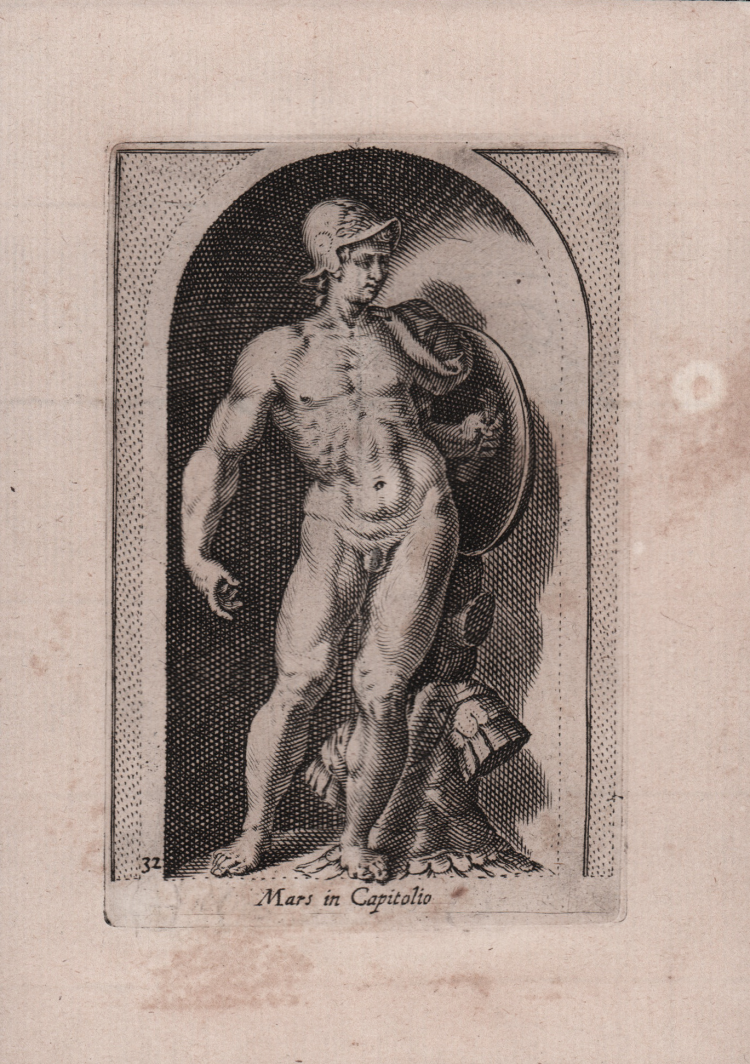




| Reference: | S49054 |
| Author | Philippe THOMASSIN |
| Year: | 1599 ca. |
| Measures: | 80 x 122 mm |



| Reference: | S49054 |
| Author | Philippe THOMASSIN |
| Year: | 1599 ca. |
| Measures: | 80 x 122 mm |
Despite the precise indication of the legend “in Capitolio”, there is no trace of this sculpture in either the Museo dei Conservatori or the Capitoline Museum.
Engraving, circa 1599, from the series ANTIQUARUM STATUARUM URBIS ROMAE LIBER PRIMUS, designed, engraved, and printed in Rome by Philippe Thomassin. Example in the first state of two.
Philippe Thomassin was an engraver and publisher, a native of Troyes, active in Rome from 1585. In 1588 he began publishing his works. In 1589 he began a partnership with Jean Turpin; their company was described in the act of dissolution of January 19, 1602 as devoted to 'the practice of painting and engraving, for the purchase and sale of engravings printed by them or by their order, for sale abroad at retail and wholesale...' In 1590 he was arrested and interrogated by the Sacro Offizio for a portrait-which he would engraved of Henry IV of France. In his early years in Rome he worked for publishers such as Claudio Duchetti, Lorenzo Vaccari and Marcello Clodio. He bought old plates, even a group from the heirs of Aliprando Caprioli in 1599 for which he requested a 10-year privilege from Pope Clement VIII in the same year. In 1603 he published two engravings by Francesco Villamena. Baglione said he liked to focus more on religious subjects, but not exclusively, as the important collection Antiquarum Statuarum Urbis Romae shows.
Beautiful proof, printed on contemporary laid paper, with margins, minimal oxidation, otherwise in excellent condition.
Bibliografia
E. Bruwaert, La vie et les oeuvres de Philippe Thomassin Graveur Troyen (1562-1622), 1914, n. 275; The De Rossi family, 497, 534, 1993; Indice delle stampe De Rossi, 17, c. 6, 1735; Indice delle stampe De Rossi, 12, c. 2, 1677; L’Antiquarum Statuarum Urbis Romae fra antichità e collezionismo, in “Bollettino d'Arte” volume speciale VI serie 1995.
Philippe THOMASSIN (Troyes 1562 - Roma 1622)
|
Engraver and print publisher, from Troyes. Active in Rome from 1585 .
C.1589 he entered into a partnership with Jean Turpin; it was described in the dissolution agreement of 19 January 1602 as a society ‘for the practice of painting and engraving,for the purchase and sale of engraved works printed by them or on their orders,for retail and wholesale trading and the sending abroad of such works…’
In 1590 he was arrested and interrogated by the Holy Office on account of a portrait of Henry IV of France that he had engraved.
In his early years in Rome he worked for print publishers such as Claudio Duchetti, Lorenzo Vaccari and Marcello Clodio. In 1588 he began to publish his own work. He bought old plates, as for example the group acquired from the heirs of Aliprando Caprioli c.1599, for which he applied for a ten-years privilege from Clement VIII in that year. In 1603 he published two engravings by Villamena . Baglione said that he largely concentrated on religious subjects. But this was not exclusively the case, as is shown by important collections such as the Antiquarum Statuarum Urbis Romae.
|
Philippe THOMASSIN (Troyes 1562 - Roma 1622)
|
Engraver and print publisher, from Troyes. Active in Rome from 1585 .
C.1589 he entered into a partnership with Jean Turpin; it was described in the dissolution agreement of 19 January 1602 as a society ‘for the practice of painting and engraving,for the purchase and sale of engraved works printed by them or on their orders,for retail and wholesale trading and the sending abroad of such works…’
In 1590 he was arrested and interrogated by the Holy Office on account of a portrait of Henry IV of France that he had engraved.
In his early years in Rome he worked for print publishers such as Claudio Duchetti, Lorenzo Vaccari and Marcello Clodio. In 1588 he began to publish his own work. He bought old plates, as for example the group acquired from the heirs of Aliprando Caprioli c.1599, for which he applied for a ten-years privilege from Clement VIII in that year. In 1603 he published two engravings by Villamena . Baglione said that he largely concentrated on religious subjects. But this was not exclusively the case, as is shown by important collections such as the Antiquarum Statuarum Urbis Romae.
|